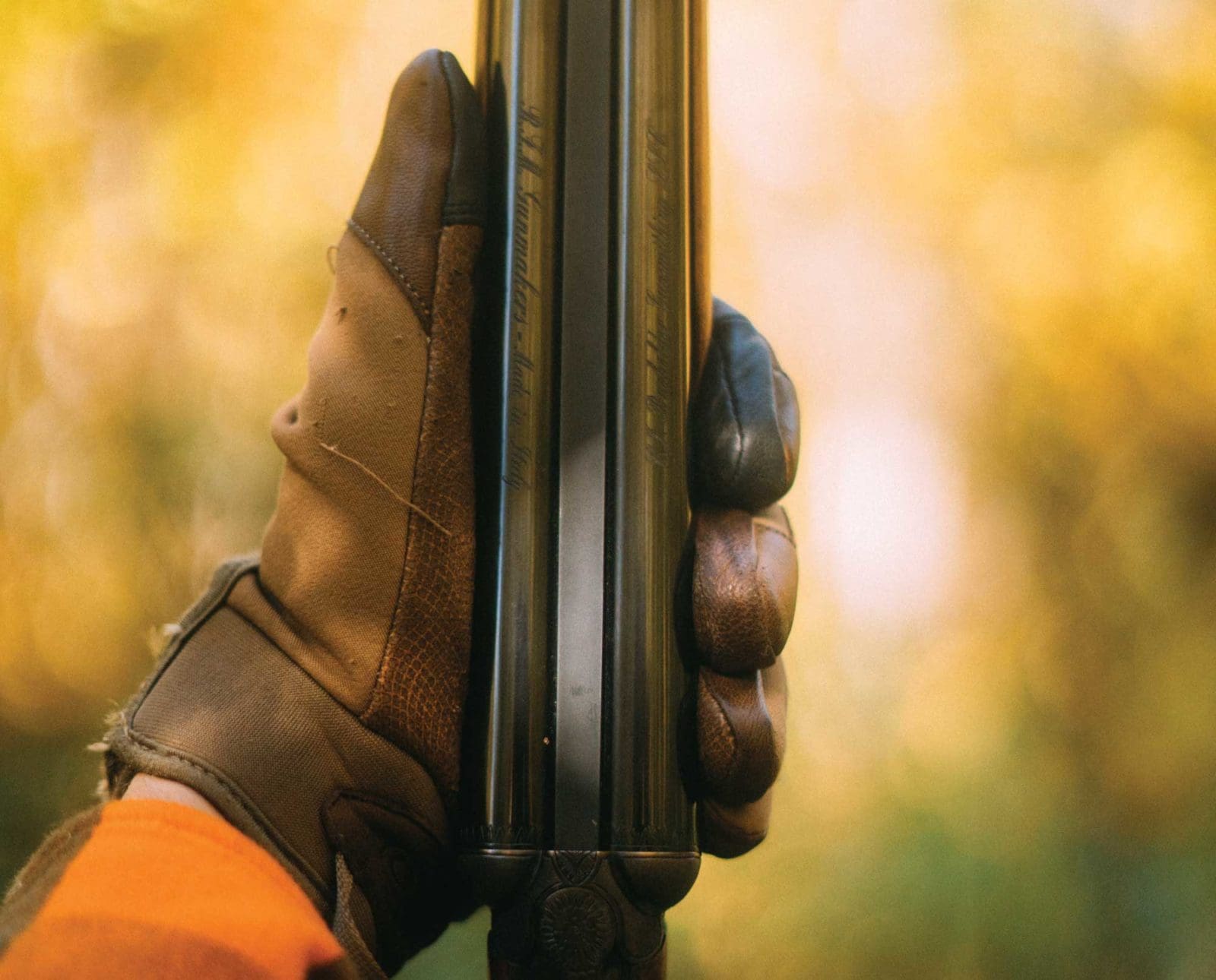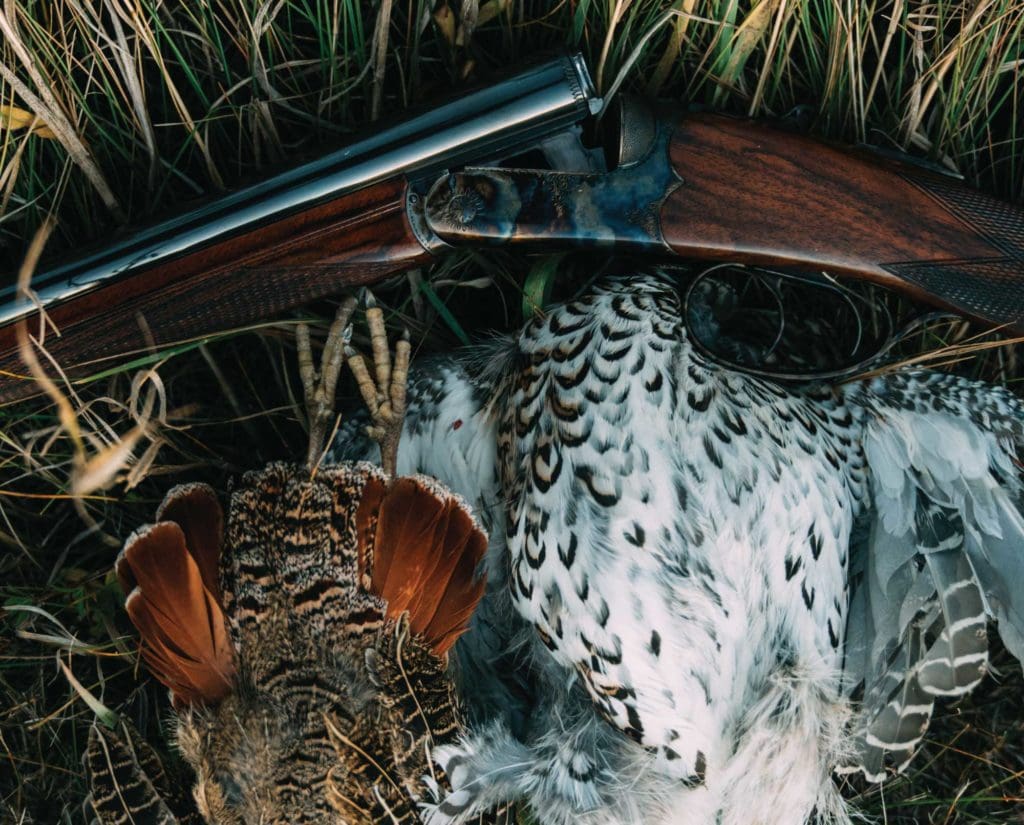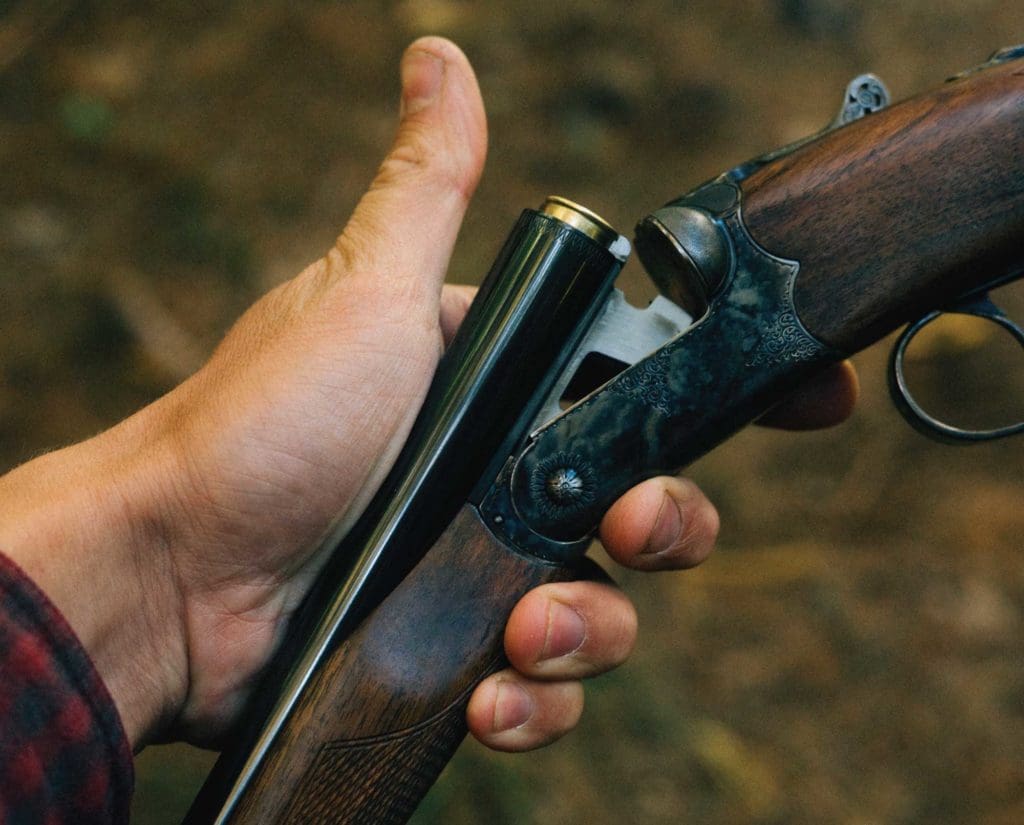Home » Firearms and Shooting » Shotguns » 28-Gauge: The Exception of the Sub-Gauge Shotgun
28-Gauge: The Exception of the Sub-Gauge Shotgun

A.J. DeRosa, founder of Project Upland, is a New England…
Is the 28-gauge the best shotgun gauge for upland hunters?
Uncertainty is one of the great allures of hunting. In my first book, I wrote that whitetail deer do exactly what they are supposed to except when they don’t. Since then, I have learned with conviction that ruffed grouse are even more mysterious than whitetail. That, along with my personal experiences, have made me quite partial to the 28, a wonderful sub-gauge with ever-growing popularity.
Listen to more articles on Apple | Google | Spotify | Audible
People smarter than me have pointed out that all shotgun ballistics apply except when talking the 28-gauge.
Grassroots conversations regarding the 28-gauge feel more like the passing on of old fantasy stories rather than true, hard facts of ballistics. People smarter than me have pointed out that all shotgun ballistics apply except when talking the 28-gauge. There are myths of its origins, a collective misunderstanding of the “square load,” and a devout following by some of the greatest shotgun experts and writers.
At 150 pounds soaking wet, I have found a love for the 28-gauge shotgun. On a recent hunting trip, three of us toted 28s of various makes and models. The previous days featured limits of ruffed grouse and woodcock under leaf-covered trees in cover I call “Mars.” We used a mix of shells by various makers ranging from #6 and #7 bismuth to #8 lead. All proved effective.
On many occasions, I have witnessed shooters of all experience levels shoot 28-gauges for the first time and push their limits on sharptails and huns. My first time taking a 28-gauge into the prairie resulted not just in limits of birds, but a double on Hungarian partridge. Simply put, others and I have found the 28-gauge to not just be a delightful gauge, but superior to other gauges in unexpected ways.
A lot of that technical shooting success is due to a properly fitting stock, the weight of the shotgun, and effectiveness of the load. Put simply, I’ve never shot another gauge better. I have come to find that it’s not just a pattern test that makes the greater case for the 28-gauge; it’s many smaller parts that make up this firearm.
Does the 28-gauge shotgun pattern better than any other gauge? Is it superior to its bigger cousins, the 20, 16, and 12-gauge? How far does it leave the .410 in its dust? Is it better at killing game? And how has it changed over the last 100+ years of shotgunning science? Here I shed light on these topics by diving into the work of shotgun experts.

The History of the 28-Gauge
Rewind your clocks to the late 19th century and dive into the shotgun era. There, we will find a much different spread of gauges than one would today. Both the
8-gauge and 10-gauge were common and popular. The 12-gauge already showed an edge in overall popularity as the “pigeon gun.” The 16-gauge overtook the 20 gauge in any serious circle. The 2-bore, 4-bore, 14-bore, 24-bore, and the .360 (smaller than the .410) also existed in the mix. Not all antiquated gauges were lost to history; finding something like a 32-gauge is not completely impossible. But good luck finding ammunition.
Many would like to crown Parker Bros, an American gunmaker, for the invention of the 28-gauge in 1903. However, that myth is busted. While that introduction was absolutely the catalyst for the popularization of the gauge stateside, it has a much older history. Ammunition companies in England were creating 28-gauge shotshells as far back as 1857 according to the writings of W.W. Greener. And as far as taking gauges seriously, the 28-gauge appeared in a lot of writing of the time. It was a common player in that regard.
But the true popularity of the 28-gauge came later. Once believed to be an inferior killer of wild game, advancements in gunpowder, the shotcup, and even the introduction of new metals would catapult this gauge forward in the modern era. The 28-gauge now represents an often-coveted selection in vintage-built shotguns that can drive prices to nauseating levels. The rarity, demand, and modern manufacturing of the 28-gauge is making this rising star even more accessible.
A 2022 survey revealed a lot of evidence about the 28-gauge’s popularity. The 28-gauge is favored by older demographics with good taste; baby boomers come in at 12.12 percent listing it as their preferred gauge. Almost 10 percent of upland hunters preferred the 28-gauge to other gauges, making it the fourth most popular gauge overall. The .410 lagged behind by a large gap at 0.37 percent and the 16-gauge just ahead at 14.57 percent. The 20-gauge comfortably continues to hold the number one spot.
When it comes to upland game species, the 28-gauge is most popular among bobwhite quail hunters, followed by ruffed grouse and woodcock hunters. Side-by-side shotgun shooters made up for 49.35 percent of the 28-gauge crowd, followed by 44.16 percent in over/under. Twenty-six percent of those respondents said they shoot a vintage shotgun that was not proofed for steel. This all builds a story that the 28-gauge is slowly, steadily gaining popularity as a gauge of choice for upland hunting.
The Myth of the 28-Gauge Square Load
A square load is defined by the bore diameter and shot column being a perfect 1 to 1 ratio. Historically, it has been found more than once that the closer a ratio is to square, the greater the effective pattern is. We will talk about string theory later. But the idea that a 28-gauge is “square” is nothing but a myth.
A 2014 study conducted by Moser and his team showed a direct correlation between the efficiency of a load and this “square load” ratio. The test was a measure of pattern efficiency at 40 yards in a 30” circle. Efficiency was calculated by the number of pellets on target divided by the total shell pellet count. In short, both the 20-gauge and 16-gauge outperformed the 28-gauge. The 12-gauge was not part of the study.
Although many people refer to a ¾ oz 28 ga load as ‘square,’ by definition it is not. At a bore diameter of 0.55”, a ¾ oz lead payload column height is about an inch (1”/.55” = 1.8); not very square.
Adam Moser, Director of Product Engineering at Federal Ammunition
“Although many people refer to a ¾ oz 28 ga load as ‘square,’ by definition it is not. At a bore diameter of 0.55”, a ¾ oz lead payload column height is about an inch (1”/.55” = 1.8); not very square,” said Adam Moser, Director of Product Engineering at Federal Ammunition. “A square load for 28-gauge would be around 7/16 oz for small lead shot like #7.5. Shot size and material will make a difference, as bigger shot and less dense material will affect the ‘packing’ density,” or how well the shot stacks in the wad. No such load is available on the market.
| 28-Gauge | |
| Bore Size (Cylinder) | .550″ |
| Skeet Choke | .547″ |
| Improved Cylinder (IC) | .545″ |
| Light Modified (LM) or Skeet II | .543″ |
| Modified (MOD) | .538″ |
| Improved Modified (IM) | .534″ |
| Full Choke | .528″ |
Does the 28-Gauge Pattern Better than Other Gauges?
The short answer? It’s complicated. We have already shown that the theories of square loads become more effective for much larger gauges. But modern shotshell construction adds in the factor of shotcups. The idea behind the square load has to do with pellet deformity. Shotcups can create less deformity when coming out of the barrel. The more shot you shoot out of a smaller hole, the more deformed, and therefore erratic, shot pattern happens. Shotcups can eliminate some of that deformity, taking the edge off the standard theories of pellet deformity and square loads.
But perhaps where the 28-gauge performs best is shot string. Shot string is how many pellets arrive at a target simultaneously. It’s measured by shooting at a large, fast-moving paper target. Imagine someone driving a station wagon pulling a boat trailer rigged up with a 16’x4’ target for you to shoot at. This method is why no greater introduction could be made of the late Bob Brister, a man of many accomplishments.
Most of his writings, tests, and musings maintained a general rule: the 28-gauge always did better than it should have.
His book, Shotgunning: The Art and Science, stands as testament to pushing the understanding of shotgun ballistics to a new level. He was devoted when it came to the 28-gauge. Most of his writings, tests, and musings maintained a general rule: the 28-gauge always did better than it should have. It was shot string that was the final evidence Brister needed to make a case for the 28-gauge. “The 28-gauge hit the pattern board so hard it jarred out one of the thumbtacks holding the paper,” Brister noticed.
Brister points out that the first person to study shot string was H. A. Ivatt in 1890. He used a train traveling 11 mph. The speed proved to be too slow to show any real difference in pattern; upland birds can fly much faster. Brister tried the method at adequate speeds:
I fired several 35-yard 40-mile-an-hour tests with the tight left barrel of my Webley & Scott 28-gauge and carefully measured the spread. Maximum between flyer pellets was 54 inches, but almost all the pattern was concentrated within a basic spread of three feet. There was virtually no stringing of shot evident; the pattern was almost as perfectly round as if it had been fired with the target sitting still. In other words, that 28-gauge with that load had a shot string, with most of its pellets arriving at the target nearly the same time. Which perhaps helps explain why 28-gauges in general have developed such a reputation for hitting game harder and smoking targets better than they are supposed to.
“The most significant findings would seem to be the addition of a new dimension to consideration of the shot string and what it means to clean-killing effectiveness with modern loads,” Brister concluded.

Other Reasons the 28-Gauge is an Ideal Gauge
Wild bird hunting is a cornerstone of the Project Upland brand. The practicality of hunting gear in environments where wild birds live is another one. William Harnden Foster defined the grouse gun as “the one that a certain hunter will find most pleasant to carry to the spot where a grouse is to be shot at, and there prove most efficient when the shot is made.”
Weight is a key factor in that basic definition. According to the 1888 book Modern Shot Guns, “A 28-gauge double gun with 26-inch barrels should weigh under 4½ lbs.” That is much lighter than its more popular cousins. As Brister would say, it’s “the exception of the 28-gauge, which simply kills better than it’s supposed to.”
Before modern shotshells were invented, it was said that the 28-gauge’s effective killing range was 35 yards and under. The lion’s share of wild upland bird hunting happens at this distance. Tighter chokes account for birds beyond that range with ease. Brister, using data from the National Skeet Shooting Association, speculated “the 28-gauge shooter would be giving up only three to four percent between his little gun and the 12-gauge.”
A collection of factors make up the 28-gauge’s uniqueness and attractiveness. The advent of newer technology has only helped its case. While I will not say on paper that 28s are superior to all other gauges, pound-for-pound, it may be the most well-rounded hunting gauge. For two seasons now I’ve made it my primary gauge, leaving the 20-gauge behind after almost 30 years with no regrets. More game in the bag was just a bonus considering all the other factors that make this such a wonderful gauge.
“There are shooters who definitely can put more birds into the sack with a lightweight 20 or 28 gauge than they can with a heavier 12,” wrote Brister, “But this is not due to gauge but to balance, weight, gun fit, recoil, speed of swing—or maybe how well a man likes his gun.”
A.J. DeRosa, founder of Project Upland, is a New England native with over 35 years of hunting experience across three continents. His passion for upland birds and side-by-side shotguns has taken him around the world, uncovering the stories of people and places connected to the uplands. First published in 2004, he wrote The Urban Deer Complex in 2014 and soon discovered a love for filmmaking, which led to the award-winning Project Upland film series. A.J.'s dedication to wildlife drives his advocacy for conservation policy and habitat funding at both federal and state levels. He serves as Vice Chair of the New Hampshire Fish & Game Commission, giving back to his community. You can often find A.J. and his Wirehaired Pointing Griffon, Grim, hunting in the mountains of New England—or wherever the birds lead them.






AJ, always enjoy your articles. Thanks for your good works. Most curious about your shot string test with the 28 ga. No mention of a side by side test with other gauges? Curious? Thanks again, Fellow Griff fanatic.
Thank you for the kind words. The test referred to in the article is a test Bob Brister did that he presents in his book Shotgunning: The Art and Science. Great read. I have yet to get that ambitious on my paper testing.
As an owner of several 28-gauge shotguns, I could not agree more with the author. The light weight and easy swinging ability appear to make me a better and even quicker shot. I started shooting the 28 after a rotator cuff surgery and haven’t put it down. My only wish was that I started earlier in life! I have been shooting skeet and 5 stand with my guns the past few years and have come to the conclusion I have very little target loss compared to a larger bore, and a much, much, much more pleasant shooting experience!
Thank you for a wonder article!
I’ve been shooting my Weatherby 28 for 35 years, even when a few others scoffed a bit…from quail to pheasants, it’s clearly an awesome gauge and the weight of the gun is a major bonus! My main gig is ruffed grouse here in NW Wisconsin and dragging a 12 through grouse/woodcock cover is too much of a workout, period! Thx for this informative and very interesting article! If others aren’t on the bandwagon….woe to them!
I found the article interesting. I learned that a square load is from the blackpowder days meaning equal amounts of powder and shot! Another thing to consider is that many of our mountain men and early settlers used a .54 caliber flintlock / cap lock and often used shot for game birds. I think they proved the 28 gauge way back before the 28 became a cartridge !
Love my AYA 28 but it let me down on no miss grouse shots last fall . Might have been the loads or a crooked eye but, clear let downs. Thought I was in range and dead on but birds flesw on. I find that for woodcock it is great because usually in close and minimal damage to the meat. Also nice to carry if one is in the field [sorry, the alders] for the day
Appreciate this hard info.
Also developed a crack in the stock . I’m looking for the right gunsmith in New Brunswick or Nova Scotia to take a look at it
Hmmm – dead on???? Methinks maybe not????
A square load is an equal amount of powder and shot by volume. It has nothing to do with the shape or height of shot in relation to bore diameter.
You are correct in that that is the method used for muzzleloader ballistics. I did some research on this after another comment from someone talking about how blackpowder was done in that manner back in the day. Modern shotgun ballistics have moved towards it being only the relation of the shot itself because ultimately the breakthrough that “shot deforms shot” is where all the ballistics change. The deformity mentioned in the research above by professional ballistician all refer to it as a “square load” in relation to only the shot column. As far as when it started to be measured in that manner, I am unsure. But I have found studies as far back as the 50’s referring to only shot in square load theory.
Indeed! And I agree with it totally. 💯 All told, the technical stuff you talk about along with the fit, the balance, and the less than 5 lb carrying weight, make my 28ga Ruger Red Label O/U the most enjoyable and effective gun I’ve used. About 40 years now. (Even though you only talked about smaller birds, I find that it is just as effective on bigger and stronger birds like pheasants and chukars.)
I find shot string interesting, but not practically useful. For some serious details on shot string, check out Surviving Duck Season on Youtube where they actually filmed the shot string with a super slo-mo camera. But for some math at 40 yards: @ 645fps and a 10 foot shot string, your shot will pass through the kill zone in .015 seconds. A game bird flying @35mph (51fps) with a 1 foot diameter will pass through the kill zone in .02 seconds, slightly slower than the shot. I don’t see how a moderate change in length of shot string or speed of shot is going to make any difference on whether you kill the bird. If anything, the argument could be made that a longer shot strong is better because it’ll have more time in the kill zone and realistically I only need a couple bb’s in the bird to bring it down, not 80 pellets all smoking the bird at once. But again I don’t think you can really affect shot string at all. Go take your gun, swing it as fast as you can, and shoot into a pond…the shot will not be horizontal, no matter how fast you swing that barrel because the shot is too fast. Hitting the target (with penetration) is more important than hitting it hard, and you only have a fraction of a second to make that happen. You pattern density, from a circular view, will have much more impact on your success than will the shot string. Just my $.02
I agree. If you research or test shot string, you will find that it is completely unimportant and amounts to a few inches at most, at least in modern shells at 40 yds or under. The 28 does NOT kill birds better than other gauges, simple science has proven this beyond any doubt, and I say that being a huge 28g fan. What the 28 does do well is get up fast, swing easy and fast, and it does not fatigue or intimidate shooters as much as the larger gauges do. This means that you are not as tired when birds get up, you do not flinch or raise your cheek as often and follow up shots are smooth and easy. They are great fun, for sure.